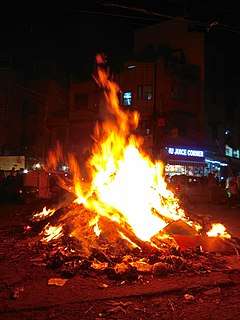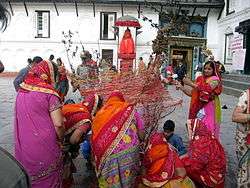Holika Dahan
Holika Dahan also Kamudu pyre is celebrated by burning Holika, an asura. For many traditions in Hinduism, Holi celebrates the killing of Holika in order to save Prahlad, a devotee of God Vishnu and thus Holi gets its name. In olden days, people used to contribute a piece of wood or two for the Holika bonfire, and this represents Holika being consumed by the fire in which she tried to kill her nephew Prahlad.
| Holika Dahan | |
|---|---|
 Holi Bonfire at Shri Ram Chowk, I.P Extension, Delhi. | |
| Type | Hindu |
| Celebrations | The day after Holika Dahan On Holi: spray colors on others, dance, visit each other, party; eat festival delicacies |
| Begins | Phalgun Purnima or Pooranmashi (Full Moon) |
| Date | February–March |
| Related to | Holi |
Significance

The night before Holi, pyres are burnt in North India, Nepal and parts of South India in keeping with this tradition.[1] The youth playfully steal all sorts of things and put them in Holika pyre.
In some parts of India the day is actually called Holika Dehan.[2] There are other activities associated with the story of Prahlad, but the burning of Holika is the one that we can most directly associate with Holi. Fire burnt on the eve of Holi (Holika Dahan) symbolizes the burning of Holika. The story as a whole is testament to the power of devotion (bhakta) over the evil represented by King Hiranyakashyapu, as Prahlad never lost his faith.
The Ritual

- Prepare Holika pyre for bonfire
Days before the festival people start gathering wood and combustible materials for the bonfire in parks, community centers, near temples and other open spaces. On top of the pyre is an effigy to signify Holika who tricked Prahalad into the fire. Inside homes, people stock up on color pigments, food, party drinks and festive seasonal foods such as gujiya, mathri, malpuas and other regional delicacies.
- Holika dahan
On the eve of Holi, typically at or after sunset, the pyre is lit, signifying Holika Dahan. The ritual symbolises the victory of good over evil. People sing and dance around the fire. People also perform parikrama of fire.
The next day people play Holi, the popular festival of colors.
Reason for Holika dahan
The burning of Holika is the most common historical explanation for the celebration of Holi. In different parts of India varying reasons are given for Holika's death. Among those are:
- Vishnu stepped in and hence Holika burnt.
- Holika was given the power by the Brahma on the understanding that it can never be used to bring harm to anyone.
- Holika wore a shawl that would protect her from fire. So when she was asked by her brother Hiranyakasyap to sit in the fire with Prahlad she put on the shawl and sat Prahlad down in her lap. When the fire was lit Prahlad began praying to Lord Vishnu. So Lord Vishnu summoned a gust of wind to blow the shawl off of Holika and on to Prahlad, saving him from the flames of the bonfire and burning Holika to her death.[3]
References
- Singh, S. Harpal (27 March 2013). "Forests bear the brunt of Holi". The Hindu. Retrieved 9 January 2020 – via www.thehindu.com.
- "Holika Dahan Burning Time and Muhurat in 2020 All Around the World". Holi festival 2020. 2020-01-16. Retrieved 2020-02-11.
- The Meaning of Holi Parmarth Archived 2012-09-09 at Archive.today Retrieved on 26 October 2007
